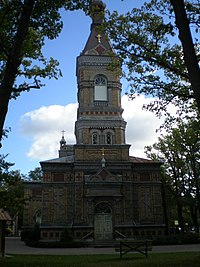| The Lord's Transfiguration Orthodox Church | |
|---|---|
 The Lord's Transfiguration Orthodox Church, Pärnu The Lord's Transfiguration Orthodox Church, Pärnu | |
| 58°23′02″N 24°30′22″E / 58.383984°N 24.505975°E / 58.383984; 24.505975 | |
| Location | Pärnu |
| Country | Estonia |
| Denomination | Eastern Orthodox Church |
| History | |
| Consecrated | 1904 (1904) |
The Lord's Transfiguration Orthodox Church (Estonian: Pärnu Issandamuutmise kirik) is an Orthodox church in Pärnu, Estonia. The church belongs to Estonian Apostolic Orthodox Church.
The church was built in 1902–1904. The church was designed by Vladimir Lunski and Karl Klein. In 1904, the church was inaugurated. The building's height is 38 m.
In 1910, the church's congregation had 5757 members; in 1939, 3006 members.
References
- ^ "Pärnu Issandamuutmise kogudus". Eesti Apostlik-Õigeusu Kirik (in Estonian). Retrieved 22 December 2020.
| Buildings and structures | |
|---|---|
| Precincts |
|
| Nature and parks | |
| Beaches | |
| Cultural institutions | |
| Sports | |
| Transportation | |
| Entertainment | |
This article about an Estonian building or structure is a stub. You can help Misplaced Pages by expanding it. |
This Pärnu-related article is a stub. You can help Misplaced Pages by expanding it. |